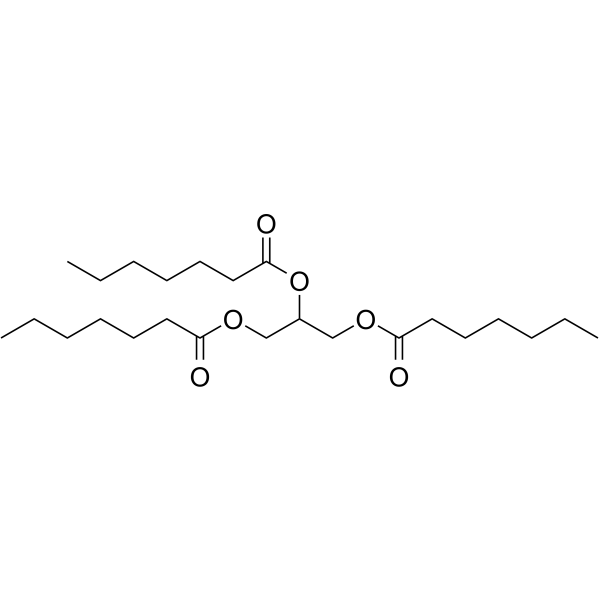620-67-7
| Name | triheptanoin |
|---|---|
| Synonyms |
Triheptanoin
Glycerol-1,2,3-triheptanoate TRIHEPTANION trioenanthoin Propane-1,2,3-triyl triheptanoate trienanthoin propane-1,2,3-triyl trisheptanoate 1,2,3-Propanetriyl triheptanoate glyceryl triheptanoate glycerol trienanthate 1,2,3-tris-heptanoyloxy-propane glyceroltriheptanoate triheptylin tri-heptanoi 1,2,3-Tris-heptanoyloxy-propan Heptanoic acid, 1,2,3-propanetriyl ester triheptanoicglyceride TRIOENANTHIN |
| Description | Triheptanoin (Propane-1,2,3-triyl triheptanoate) is a synthetic medium-chain triglyceride (MCT) consisting of three odd-chain 7-carbon (heptanoate) fatty acids on a glycerol backbone. Triheptanoin can be used for the research of inherited metabolic disorders[1]. |
|---|---|
| Related Catalog | |
| In Vivo | In long-chain fatty acid oxidation disorders (LC-FAOD), Triheptanoin is used as an anaplerotic compound, acting as a source of calories and fatty acids to bypass the LC-FAOD enzyme deficiencies[1]. Triheptanoin can be used for the research of ataxia-telangiectasia (A-T)[2]. Triheptanoin functions as an anaplerotic agent replenishing tricarboxylic acid (TCA) cycle intermediates by metabolism to heptanoate (C7) and subsequently acetyl-CoA and propionyl-CoA that feed into the TCA cycle to supply energy[2]. Triheptanoin mitigates brain ATP depletion and mitochondrial dysfunction, including respiration and redox balance in a mouse model of Alzheimer's disease, supporting the energy failure hypothesis for that disorder[2]. Triheptanoin (Mice were treated with Triheptanoin (35E%) for 10 days prior to pilocarpine injection to induce status epilepticus) preserved mitochondrial functions in the hippocampal formations of pilocarpine-induced status epilepticus (SE) mice[3]. Animal Model: 7-8 week old male CD1 (35-40 g)[3] Dosage: 35E% oral Triheptanoin was mixed into mouse chow Administration: Given 35E% Triheptanoin treatment 10 days prior to SE induction Result: Preserved mitochondrial functions in SE mice. |
| References |
[1]. Matt Shirley. Triheptanoin: First Approval. Drugs. 2020 Oct;80(15):1595-1600. |
| Density | 1.0±0.1 g/cm3 |
|---|---|
| Boiling Point | 470.0±12.0 °C at 760 mmHg |
| Molecular Formula | C24H44O6 |
| Molecular Weight | 428.603 |
| Flash Point | 195.5±19.6 °C |
| Exact Mass | 428.313782 |
| PSA | 78.90000 |
| LogP | 7.73 |
| Vapour Pressure | 0.0±1.2 mmHg at 25°C |
| Index of Refraction | 1.457 |
CHEMICAL IDENTIFICATION
HEALTH HAZARD DATAACUTE TOXICITY DATA
|
|
~% 
620-67-7 |
| Literature: Ozaki Biochemische Zeitschrift, 1926 , vol. 177, p. 166 Proceedings of the Imperial Academy (Tokyo), vol. 2, p. 343 Chem. Zentralbl., 1926 , vol. 97, # II p. 2451 |
| HS Code | 2915900090 |
|---|---|
| Summary | 2915900090 other saturated acyclic monocarboxylic acids and their anhydrides, halides, peroxides and peroxyacids; their halogenated, sulphonated, nitrated or nitrosated derivatives VAT:17.0% Tax rebate rate:9.0% Supervision conditions:AB(certificate of inspection for goods inward,certificate of inspection for goods outward) MFN tariff:5.5% General tariff:30.0% |

